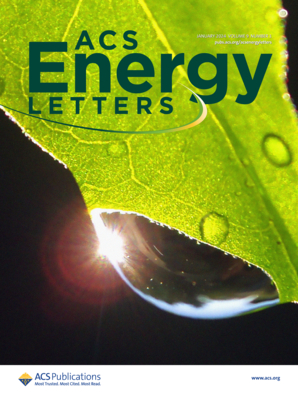Adjusting the Crystallization of Tin Perovskites through Thiophene Additives for Improved Photovoltaic Stability
IF 19.3
1区 材料科学
Q1 CHEMISTRY, PHYSICAL
引用次数: 0
Abstract
Tin-based perovskites (Sn-PVK) are promising lead-free alternatives for efficient photovoltaic technology, but they face challenges related to bulk and surface defects due to suboptimal crystallization and Sn2+ oxidation. Introducing thiophene-2-ethylammonium halides (TEAX, where X = I, Br, Cl) improves FASnI3 crystallization and reduces Sn4+ formation. This is achieved by adjusting the crystallization dynamics through the formation of a complex between S and Sn during the preparation of the precursor solution, which also inhibits Sn2+ oxidation in the resulting films. In solar cells, these additives boost power conversion efficiency (PCE) from 6.6% (without additives) to 9.4% (using TEABr), with further enhancement to 12% by adjusting selective contacts. The addition of TEAX also increases the Sn2+ content, outperforming control. Devices with TEABr maintained over 95% of their initial PCE after 2000 h in N2 under continuous operation with 1 sun simulated illumination.

通过噻吩添加剂调节锡包铝晶体的结晶以提高光伏稳定性
锡基包晶石(Sn-PVK)是高效光伏技术的无铅替代品,前景广阔,但由于结晶不理想和 Sn2+ 氧化,它们面临着块体和表面缺陷的挑战。引入噻吩-2-乙基卤化铵(TEAX,其中 X = I、Br、Cl)可改善 FASnI3 的结晶并减少 Sn4+ 的形成。这是通过在前驱体溶液的制备过程中在 S 和 Sn 之间形成络合物来调整结晶动力学来实现的,这种络合物还能抑制生成的薄膜中 Sn2+ 的氧化。在太阳能电池中,这些添加剂可将功率转换效率(PCE)从 6.6%(无添加剂)提高到 9.4%(使用 TEABr),通过调整选择性接触可进一步提高到 12%。添加 TEAX 还增加了 Sn2+ 的含量,性能优于对照组。使用 TEABr 的器件在氮气中连续工作 2000 小时后,在 1 个太阳的模拟光照下仍能保持 95% 以上的初始 PCE。
本文章由计算机程序翻译,如有差异,请以英文原文为准。
求助全文
约1分钟内获得全文
求助全文
来源期刊

ACS Energy Letters
Energy-Renewable Energy, Sustainability and the Environment
CiteScore
31.20
自引率
5.00%
发文量
469
审稿时长
1 months
期刊介绍:
ACS Energy Letters is a monthly journal that publishes papers reporting new scientific advances in energy research. The journal focuses on topics that are of interest to scientists working in the fundamental and applied sciences. Rapid publication is a central criterion for acceptance, and the journal is known for its quick publication times, with an average of 4-6 weeks from submission to web publication in As Soon As Publishable format.
ACS Energy Letters is ranked as the number one journal in the Web of Science Electrochemistry category. It also ranks within the top 10 journals for Physical Chemistry, Energy & Fuels, and Nanoscience & Nanotechnology.
The journal offers several types of articles, including Letters, Energy Express, Perspectives, Reviews, Editorials, Viewpoints and Energy Focus. Additionally, authors have the option to submit videos that summarize or support the information presented in a Perspective or Review article, which can be highlighted on the journal's website. ACS Energy Letters is abstracted and indexed in Chemical Abstracts Service/SciFinder, EBSCO-summon, PubMed, Web of Science, Scopus and Portico.
 求助内容:
求助内容: 应助结果提醒方式:
应助结果提醒方式:


